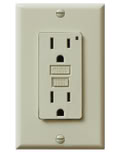What is a GFI?

GFI outlets are important, so important that the sale of our home was held up until we replaced some of our electrical outlets with GFIs. What’s the most important thing about GFI outlets? They can -- and do -- save lives.
Find out more about why and where you need GFI outlets in your household.
What is a GFI Outlet?
Short for Ground Fault Circuit Interrupter, a GFI (also known as GFCI) is a type of electrical outlet designed to protect you and your family against electrical shock, fire, and/or fatal electrocution. Your GFCI outlet (receptacle) monitors the flow of current. If it detects a ground fault -- an unintentional electrical path to the ground -- it will immediately cut the power, to protect anyone in physical contact with the electrical system.
These essential devices are inexpensive to purchase and to install. Find an experienced electrician to install GFI outlets in your home.
Where is GFCI Installation Required?
GFI protection is legally required by the National Electrical Code for all receptacles that are likely to come in contact with moisture. This includes installation in:
- outdoor areas
- swimming pool areas
- bathrooms
- garages
- kitchen
- laundry
- wet bar sink vicinity
- unfinished basements
- crawlspaces
Check your local building code to find out the exact requirements for GFCI outlet installation in your area.
How a GFI/GFCI Works
The GFI detects changes in current to any appliance connected to it (such as a toaster or blow dryer). It contains a sensor that compares the current flow to and from the appliance. If there is a potentially dangerous drop in the current, then the GFI by trips an interior relay in less than one second. This completely shuts down its power. When this happens, unplug the appliance and press the reset button on your GFCI outlet.
When a GFCI Outlet Won’t Reset
Play it safe. Contact an experienced electrician in any of the following cases:
- The GFCI outlet won’t reset
- The GFI frequently shuts down
- You suspect there’s anything wrong with your GFI outlets or your home electrical system.
Testing Your GFI
Test your GFI outlets once a month. Plug in a clock or lamp, make sure the appliance is on, and then press the GFCI test button. If the clock or lamp loses power and the reset button on the GFI outlet pops out, that’s a good sign – the GFCI is doing its job. (Now just press “reset” to get it working again.)
If the reset button pops out but the appliance does not lose power, the GFCI wiring was done incorrectly. Contact an electrician to fix the problem. If the reset button does not pop out at all, your GFCI is defective and must be replaced.
You can purchase a GFI tester at most hardware stores. It plugs into the GFI outlet, and will supply you with information about your connections, such as wiring problems and the condition of the GFI.
Types of GFCIs
There are three kinds of GFCIs for home use: receptacle, circuit breaker, and portable.
1. GFI receptacle
This is the basic GFI outlet, as pictured above, which is installed to replace older, non-GFI outlets.
2. GFI circuit breaker
These are installed in a panel box to give protection to selected circuits. The GFCI circuit breaker will shut off electricity in the event of a problem; it will also trip when a short circuit or an electrical overload occurs.
3. Portable GFI outlet
Portable GFCIs are used when there is no GFI installed nearby. For example, you may want to connect your electric lawn trimmer to a GFI outlet, but your garage does not have one. Simply plug a portable GFI into the outlet and then plug in the trimmer.
Looking for a Pro? Call us (866) 441-6648

Electrical Average Costs
Electricians Experiences

Hardworking Handyman Brings Christmas To Southern California

Light Fixture Installation By An Electrician With A Good Eye For Detail



